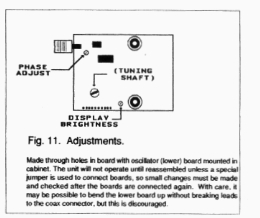

11

 |
 |
11 |
 |
|
There are two adjustments on the unit, neither of which should need attention. However, here they are:
1. LCD Brightness
Turn this to make the LCD brighter or dimmer. If too high you will see “8888.” If too low, the display will be dim and eventually the microprocessor will stop.
2. Phase Adjustment
The LCD brightness has a small effect on phase, so LCD
brightness should be adjusted first.
To adjust phase:
coax connector.
2. Set the VA1 at approx. 7 MHz.
4.Turn the phase adjustment until Rs reads 1 to 10
ohms. Try for 1 to 3 ohms.
Note: Theoretically, Rs should read zero ohms. However, the VA1 shows “negative ohms” as zero. So, if you try to set it to Rs=0 ohms, you may go too far on the adjustment. But zero is also acceptable. The phase adjustment sets the phase angle at 90 degrees. It is not as critical at smaller phase angles since a 5 degree error at 90 degrees produces only a 1/2 degree error at 9 degrees, for example.
ONE YEAR WARRANTY
Autek Research warrants this product against manufacturing defects for one full year after the original date of consumer purchase. This warranty does not include damage resulting trom accident, misuse, abuse, or unauthorized alteration. This product is not weatheiproof, so the owner must use reasonable care to protect it against the elements outdoors. Autek Research will not be responsible for consequential damages to person or property cause by use of our products. This warranty is in lieu of any other warranty expressed or implied.
If the product becomes defective during the warranty period we will repair or replace it
,
at our option, parts and labor included, if it is mailed to us postpaid with a check for $8 to cover return postage and handling ($20 outside USA) enclosed in the package. We have records of your name and date of purchase, but you must slate your purchase date (within a month) to find these and verity warranty. Include a description of the problem in the package also.
If a unit is returned without the $8 ($20) return shipping, there is an additional $3 charge for correspondence askin9 for the payment. We’re here to help you, but we cannot maintain a high level of service at low cost if excessive correspondence is required. This warranty gives you specific legal rights, and you may have other legal rights which vary from state
to
state.
Our minimum charge is $40 plus $8 shipping and handling (USA), or $20 outside USA. If you should damage the unit during the fIrst year. or the warranty has expired, this charge applies. We cannot give estimates, or even look at the unit, unless a check for $48(USA) is enclosed in the package. Also enclose a detailed description of the problem, a way to induce any intermittent, etc. It the unit appears to have nothing wrong with it, the minimum charge still applies for checkout. We can fix 95% of failures for the minimum. On the rare occasion when the charge will be more, we will get your permission belore proceeding. The service charge also applies to any unit returned within one year which simply needs calibration or has no problem; be sure there is a detect before returning.
|
SWR is only 1.0 for a resistive 50 ohms (X=0). Any X will raise the SWR. (See Equations A5 and A6 in the Appendix.)
large-value readings.
The VA1 smooths each reading ; more smoothing would slow response excessively. You should average any readings which vary. This is common at high readings. Also, the multiplexed display may show some ghost segments at large angles.
strange reading very briefly. Is something loose?
Probably not. The microprocessor is very busy. Occasionally it
will be interrupted to take a frequency measurement and make
a momentary mistake.
This is normal, due to small currents generated in the microprocessor, and has NO effect on accuracy since the oscillator bandwidth is much narrower than the antenna. The oscillator has very low
harmonic
distortion, which is what counts. Note: An AC adaptor greatly increases the raspy quality because its hum feeds through on the “fine tune” line, which is not regulated. But, accuracy should not be affected.
Most people don’t like bad news, so they like the meter which reads lower. You must test the VA1 with some 1% resistors,
say 50 ohms (1:1) and 60 ohms
(1.2 SWR) to convince yourself. Most SWR meters have “suckout” and read 1.0 below 1.2 or so. For extreme differences, see Caution on Page 1, and check your connections. Often, even a 5 watt
transmitter can
“heal” a corroded connection temporarily, but the joint opens up
when the
power is removed. This has been observed!
If you
habitually
twist
the
innerconductor of the coax plug
when attaching, the wire between the coax connector
and
the board may have broken. Check
this.
|
|
VAI Page 11
|

 |
 |
11 |
 |